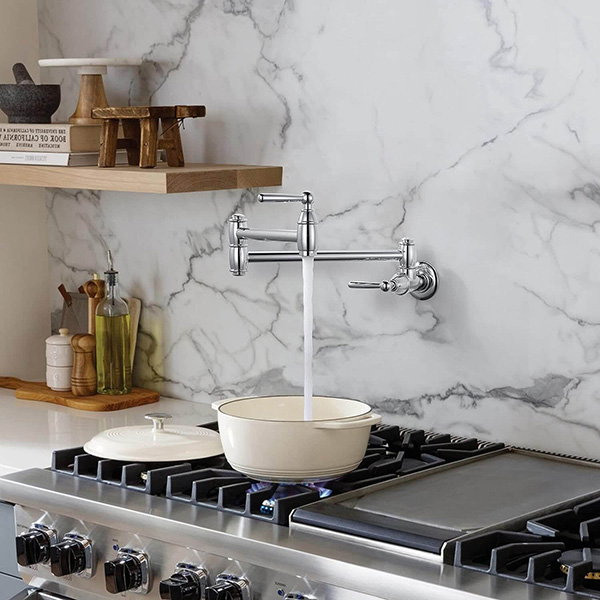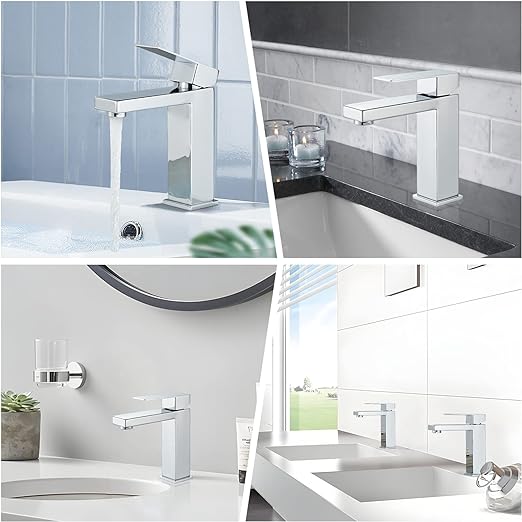Introduction
In the world of interior design and home decor, even the smallest details can make a significant impact. One such detail that often requires careful consideration is the choice of finishes for fixtures and hardware. Among the plethora of options available, two popular contenders stand out: Polished Chrome and Polished Nickel. These metallic finishes exude elegance and sophistication, but they each have distinct characteristics that can greatly influence the overall aesthetic of a space. In this article, we will delve into the unique attributes of polished chrome vs. polished nickel, exploring their history, properties, applications, and the factors to consider when choosing between them.
Historical Context of Polished Chrome vs. Polished Nickel
Before delving into the specifics, it is essential to understand the historical context of these finishes.
Polished Chrome

ARCORA Chrome Pot Filler Faucet Wall Mount Kitchen Folding Faucet
Chrome plating, which involves electroplating a thin layer of chromium onto a metal surface, gained popularity in the early 20th century. It was prized for its durability, corrosion resistance, and shiny, mirror-like appearance.
Polished chrome is a metallic finish characterized by its mirror-like, highly reflective surface. It is achieved through a process called chrome plating, where a thin layer of chromium is electroplated onto a metal surface. This finish is known for its sleek and contemporary appearance, making it a popular choice for a wide range of applications, particularly in modern interior and automotive design.
One of the key advantages of polished chrome is its exceptional durability and resistance to tarnish and corrosion. This makes it a long-lasting option for fixtures and hardware, ensuring they maintain their luster even in high-traffic or moisture-prone environments. Polished chrome’s versatility is another notable feature, as it seamlessly complements various design styles, from minimalist and industrial to classic and high-tech. Easy maintenance, with regular cleaning using mild soap and water, further contributes to its appeal, making polished chrome a practical and aesthetic choice for enhancing the visual appeal of both residential and commercial spaces.
Polished Nickel

ARCORA Polished Nickel Wall Mount Pot Filler Faucet Over Stove
Polished Nickel, on the other hand, is an alloy composed primarily of nickel, known for its lustrous, silvery-white finish. It has a rich history, often associated with classic and vintage designs.
Polished nickel is a metallic finish renowned for its warm, lustrous appearance. It is primarily composed of nickel, which gives it a silvery-white sheen with a subtle satin finish. Unlike polished chrome, which boasts a high-gloss mirror-like shine, polished nickel exudes a more understated elegance. This finish is favored for its ability to evoke a sense of classic, timeless sophistication.
One of the distinctive characteristics of polished nickel is its potential to develop a subtle patina over time. This natural aging process adds depth and character to the finish, creating a lived-in, vintage charm. Polished nickel is a versatile choice that complements a wide range of design styles, particularly those with a classic, transitional, or vintage aesthetic. While generally low-maintenance, periodic polishing with a non-abrasive cleaner may be required to preserve its luster and prevent tarnish. Overall, polished nickel’s warm and inviting glow makes it a popular option for elevating the visual appeal of interiors, offering a touch of timeless elegance to any space.
The Characteristics of Polished Chrome
1. A Mirror-Like Shine: Polished Chrome is renowned for its exceptionally reflective surface. It creates a brilliant, almost mirror-like finish that can brighten up any space.
2. Durability and Resilience: Chrome plating is highly durable and resistant to tarnish and corrosion, making it a long-lasting choice for fixtures and hardware.
3. Versatility: Due to its neutral and reflective nature, Polished Chrome seamlessly integrates into a wide range of design styles, from modern and minimalist to classic and traditional.
4. Easy Maintenance: Maintaining the shine of Polished Chrome is relatively straightforward. Regular cleaning with mild soap and water is usually sufficient to keep it looking pristine.
5. Contemporary Appeal: Its sleek and modern appearance makes Polished Chrome a favored choice for contemporary interior designs. It complements clean lines and minimalist aesthetics beautifully.
The Unique Characteristics of Polished Nickel
1. Warm Elegance: Polished Nickel exudes a warm, inviting glow that is reminiscent of the traditional elegance found in older homes. It can add a touch of timeless sophistication to any space.
2. Subtle Satin Finish: Unlike the high-gloss shine of Chrome, Polished Nickel boasts a softer, satin-like finish. This characteristic lends it a more understated and refined appearance.
3. Unique Patina Development: Over time, Polished Nickel may develop a subtle patina, adding depth and character to the finish. This natural aging process is often cherished by homeowners who appreciate the lived-in look.
4. Compatibility with Various Styles: Polished Nickel harmonizes particularly well with classic, vintage, and transitional design styles. It can evoke a sense of nostalgia while still feeling fresh and relevant.
5. Care and Maintenance: While Polished Nickel is generally low-maintenance, it may require occasional polishing with a non-abrasive cleaner to maintain its luster and prevent tarnish.
Factors to Consider When Choosing Between the Two

MOSSON Polished Chrome Bathroom Sink Faucets Vessel Sink Faucets
1. Overall Aesthetic:
Consider the style and ambiance you aim to achieve in your space. Polished Chrome lends itself well to contemporary, minimalist, and high-tech environments, while Polished Nickel brings a touch of classic, timeless elegance.
2. Existing Finishes:
Take into account the finishes of other fixtures and hardware in the space. Ensuring consistency or intentional contrast can enhance the overall visual appeal.
3. Maintenance Preferences:
Consider your willingness and ability to invest time in maintenance. Polished Chrome is generally easier to clean and maintain, while Polished Nickel may require occasional upkeep to preserve its appearance.
4. Budget:
Budgetary constraints may play a significant role in your decision. Polished Chrome tends to be more cost-effective compared to Polished Nickel, which is often considered a premium finish.
5. Personal Preference:
Ultimately, trust your instincts and choose the finish that resonates with you the most. Your personal taste and style should be the guiding factors in this decision.
Conclusion
In the debate of Polished Chrome vs. Polished Nickel, there is no definitive winner. Both finishes offer unique qualities and can greatly enhance the aesthetic of a space, depending on the desired atmosphere and existing design elements. Whether you opt for the modern allure of Polished Chrome or the timeless elegance of Polished Nickel, your choice will undoubtedly contribute to a space that reflects your personal style and taste, creating an environment that you can truly call your own.
 ARCORA FAUCETS
ARCORA FAUCETS